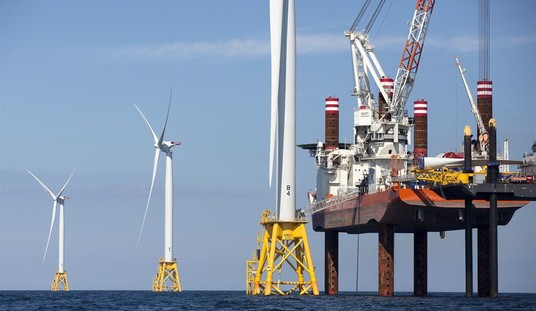Normally, state visits by US presidents follow a carefully prepared script, even more carefully prepared than on Chicagoland. Open issues only get broached if a resolution has already agreed upon by lower-ranking envoys, lest the Commander-in-Chief end up with egg on his face during his foreign-policy tour. It’s not that there is a lack of issues where Japan and the US currently agree, either, even while the open-trade agreement that has languished for years is unresolved. And yet, Barack Obama made it a point to highlight the lack of a deal on trade in his remarks in Tokyo:
While failing to seal a deal on his ambitious plan to expand trade in the Pacific Rim, President Barack Obama on Thursday said a long-stalled trade pact still can be finalized if Japan opens its markets and accepts more U.S. exports of everything from cars to farm goods.
“That’s my bottom line, and I can’t accept anything else,” Obama said at a news conference in Tokyo.
After meeting privately with Japanese Prime Minister Shinzo Abe, the president said that “important progress” had been made in trying to wrap up the deal, adding: “I continue to believe we can get this done.”
The issue, according to McClatchy, is the competing tariffs on auto sales, grains, and meat products that restrict trade between the two industrial giants. If we want to sell more ag products in Japan, we will have to lower tariffs on cars, and then enforce open-market agreements so that Japan doesn’t cheat on pricing. Needless to say, this requires stakeholders in both nations to either grudgingly agree to support the deal or to at least stop agitating against it. Neither the auto industry here nor the ag interests in Japan apparently have reached that point — so why bring it up at all, especially on a trip where the President already looks more like a tourist than a world leader?
That’s not just my assessment, but also Dana Milbank’s. He wrote his criticism on Wednesday before this flop:
The seven-day, four-country Asian tour promises to be an excellent adventure for the president. He’ll visit the Meiji Shrine in Japan and dine with the emperor. He’ll visit Gyeongbokgung Palace in South Korea and lay a wreath at the National War Memorial. In Malaysia, he will attend a “royal audience” and visit the National Mosque in Kuala Lumpur. And in the Philippines, he’ll check out an electric vehicle, place another wreath and enjoy his third state dinner.
But one thing is missing from the president’s otherwise exciting itinerary: making news. The one hope for a breakthrough on the trip — an announcement of a trade deal called the Trans-Pacific Partnership — fell through. National security adviser Susan Rice said work will continue in the “coming weeks and months.”
Obama will have the requisite news conferences with foreign leaders, although questions are likely to be about Ukraine. Rice described the purpose of the tour in vague and airy terms: “This is a positive trip with a positive agenda that underscores that the United States’ commitment to this region is growing, and is a cornerstone of our global engagement and is going to be there for the long term.”
Nothing is wrong with an American president spreading goodwill and eating good sushi, but the photo-op nature of the trip risks contributing to a perception that Obama’s Asian policy, and his foreign policy in general, is similarly itinerant. He’s seeing the sights, getting some good pics and moving along — more tourist than architect of world affairs.
Michael Auslin notes for the Daily Beast that Obama did manage to look a little more like a world leader in Tokyo on another topic, but that it’s not likely to instill confidence in our allies abroad. He set another red line, this time over the Senkaku Islands, which Obama asserted would come under the existing mutual-defense pact between the US and China. Auslin isn’t terribly impressed:
[G]lobal bullies have shown the president’s red lines to be drawn in pencil, not ink. Syria and Russia ignore the White House with impunity, while North Korea broke its only agreement with the Obama administration. Meanwhile, Iran’s leadership proclaims it will never give up its nuclear program even as it keeps the Americans tied up in negotiations.
Perhaps President Obama’s threats are simply seen as no longer credible. Beijing may well decide that the president offers little but rhetoric. In that case, it is not a question of whether the United States has the means to deter Chinese aggression (we do, for now), but whether President Obama has the will. If the leaders of revisionist or disruptive states are betting that the White House will shy away from any real confrontation, then they will embrace aggressive opportunism when the chance offers itself.
In the case of China and Japan, that could lead to the largest clash in Asia since Vietnam. The two have no relations of trust, and the trend line has shown that they are unwilling to solve their dispute peacefully. The worst outcome would be if President Obama’s promise actually worsened the situation in the East China Sea rather than stabilize it. That would truly test U.S. resolve and credibility.
Let’s hope it doesn’t come to that. This, however, demonstrates the massive damage that Obama did in drawing a red line in Syria while failing to build the requisite political support to act when it got crossed. Syria, Russia, and China may have concluded that the US now speaks loudly and carries no stick at all — and that will make the world a very dangerous place.








Join the conversation as a VIP Member